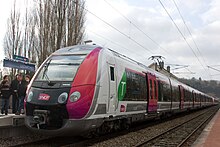SNCF Class Z 50000
| SNCF Z 50000 Francilien |
|
|---|---|

Z 50015/16 and Z 50017/18 units on the same platform during inauguration day, at the gare de Luzarches
|
|
| Manufacturer | Bombardier, Crespin |
| Capacity | Seated: 405†/503* Standing: 468†/552* (at 4 per square metre) |
| Specifications | |
| Train length | 94,300 mm (309 ft 5 in)† 112,500 mm (369 ft 1 in)* |
| Car length | 16.53 m (54 ft 3 in) (end car) 13.24 m (43 ft 5 in) (intermediate cars) |
| Width | 3,060 mm (10 ft 0 in) |
| Height | 4,280 mm (14 ft 1 in) |
| Entry | 985 mm (38.8 in) |
| Wheel diameter | 840 mm (33 in) |
| Wheelbase | 1,900 mm (75 in) |
| Maximum speed | 140 km/h (87 mph) |
| Weight | 240 tonnes (240 long tons; 260 short tons)* / 210 tonnes (210 long tons; 230 short tons)† |
| Power output | 2.95 MW (3,960 hp)* (2.62 MW or 3,510 hp continuous) |
| Acceleration | 0.87 m/s2 (2.9 ft/s2) (0 to 50 km/h or 0 to 31 mph)* |
| Deceleration | 1.05 m/s2 (3.4 ft/s2)* |
| Electric system(s) | 1.5 kV / 25 kV AC Catenary |
| Current collection method | Pantograph |
| Coupling system | Scharfenberg coupler |
| Notes | |
| Sources: except where noted * Eight car train, † Seven car train |
|
The SNCF Z 50000 is an electric multiple unit train built by Bombardier Transportation (manufacturer's designation SPACIUM 3.O6) for the French rail operator SNCF, for use under Transilien operations in the Île-de-France.
It is commonly called ‘Francilien’, and sometimes ‘NAT’ (for French: «Nouvelle Automotrice Transilien», which was its project name).
In 2004, STIF began the tendering process for approximately 180 new trains, Nouvelle Automotrice Transilien (NAT) to replace the railcars nicknamed INOX: SNCF Z 5300; Z 6100; and trains using RIB-RIO (Rame Inox Banlieue, Rame Inox Omnibus.) push-push trainsets. Alstom, Siemens and Bombardier were initial involved in the bidding process.
In 2006 Bombardier obtained a contract from SNCF and STIF for 172 ‘Francilien’ trainsets, with an option for 200 more. (cost €1.850 billion.) The design was for a train operating a typical journey of 30 to 50 kilometres (31 mi) length, including numerous stop lasting 30 to 40 seconds, and able to operate from either 1.5 kV DC or 25 kV AC overhead line electrification.
The vehicles use an articulated design using Jakobs bogie intercarriage articulation. of seven or eight carriages; seating layout is [3+2] formation giving over 400 seats in a seven-car unit, over 500 in an eight-car set. Total occupation exceeds 800 (or 1000 in eight-car trains) including standing passengers at 4 per square meter.
The vehicle's width is 3.06 metres (10.0 ft), wider than previous trains, which is achieved by having a short standard carriage's length of 13.24 metres (43.4 ft). The inter-carriage passages are wide, limiting .
...
Wikipedia
